Related Research Articles

The cut-up technique is an aleatory literary technique in which a written text is cut up and rearranged to create a new text. The concept can be traced to the Dadaists of the 1920s, but it was developed and popularized in the 1950s and early 1960s, especially by writer William S. Burroughs. It has since been used in a wide variety of contexts.

Dada or Dadaism was an art movement of the European avant-garde in the early 20th century, with early centres in Zürich, Switzerland, at the Cabaret Voltaire, founded by Hugo Ball with his companion Emmy Hennings, and in Berlin in 1917. New York Dada began c. 1915, and after 1920 Dada flourished in Paris. Dadaist activities lasted until the mid 1920s.

William Carlos Williams was an American poet, writer, and physician closely associated with modernism and imagism.

A found object, or found art, is art created from undisguised, but often modified, items or products that are not normally considered materials from which art is made, often because they already have a non-art function. Pablo Picasso first publicly utilized the idea when he pasted a printed image of chair caning onto his painting titled Still Life with Chair Caning (1912). Marcel Duchamp is thought to have perfected the concept several years later when he made a series of ready-mades, consisting of completely unaltered everyday objects selected by Duchamp and designated as art. The most famous example is Fountain (1917), a standard urinal purchased from a hardware store and displayed on a pedestal, resting on its back. In its strictest sense the term "ready-made" is applied exclusively to works produced by Marcel Duchamp, who borrowed the term from the clothing industry while living in New York, and especially to works dating from 1913 to 1921.
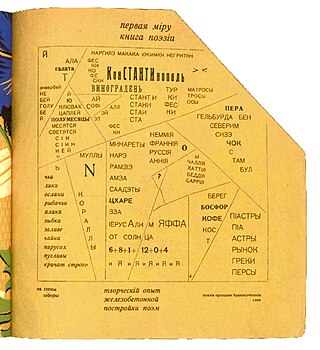
Concrete poetry is an arrangement of linguistic elements in which the typographical effect is more important in conveying meaning than verbal significance. It is sometimes referred to as visual poetry, a term that has now developed a distinct meaning of its own. Concrete poetry relates more to the visual than to the verbal arts although there is a considerable overlap in the kind of product to which it refers. Historically, however, concrete poetry has developed from a long tradition of shaped or patterned poems in which the words are arranged in such a way as to depict their subject.

Modernist poetry in English started in the early years of the 20th century with the appearance of the Imagists. Like other modernists, Imagist poets wrote in reaction to the perceived excesses of Victorian poetry, and its emphasis on traditional formalism and ornate diction.
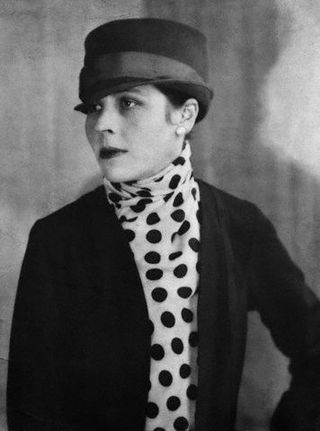
Djuna Barnes was an American artist, illustrator, journalist, and writer who is perhaps best known for her novel Nightwood (1936), a cult classic of lesbian fiction and an important work of modernist literature.
Neo-Dada was a movement with audio, visual and literary manifestations that had similarities in method or intent with earlier Dada artwork. It sought to close the gap between art and daily life, and was a combination of playfulness, iconoclasm, and appropriation. In the United States the term was popularized by Barbara Rose in the 1960s and refers primarily, although not exclusively, to work created in that and the preceding decade. There was also an international dimension to the movement, particularly in Japan and in Europe, serving as the foundation of Fluxus, Pop Art and Nouveau réalisme.
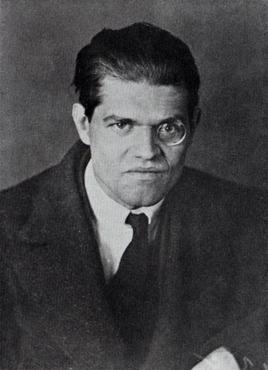
Raoul Hausmann was an Austrian artist and writer. One of the key figures in Berlin Dada, his experimental photographic collages, sound poetry, and institutional critiques would have a profound influence on the European Avant-Garde in the aftermath of World War I.
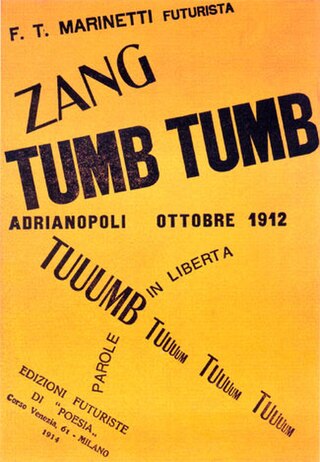
Zang Tumb Tumb is a sound poem and concrete poem written by Filippo Tommaso Marinetti, an Italian futurist. It appeared in excerpts in journals between 1912 and 1914, when it was published as an artist's book in Milan. It is an account of the Battle of Adrianople, which he witnessed as a reporter for L'Intransigeant. The poem uses Parole in libertà and other poetic impressions of the events of the battle, including the sounds of gunfire and explosions. The work is now seen as a seminal work of modernist art, and an enormous influence on the emerging culture of European avant-garde print.
"[The] masterpiece of Words-in-freedom and of Marinetti’s literary career was the novel Zang Tumb Tuuum... the story of the siege by the Bulgarians of Turkish Adrianople in the Balkan War, which Marinetti had witnessed as a war reporter. The dynamic rhythms and onomatopoetic possibilities that the new form offered were made even more effective through the revolutionary use of different typefaces, forms and graphic arrangements and sizes that became a distinctive part of Futurism. In Zang Tumb Tuuum; they are used to express an extraordinary range of different moods and speeds, quite apart from the noise and chaos of battle.... Audiences in London, Berlin and Rome alike were bowled over by the tongue-twisting vitality with which Marinetti declaimed Zang Tumb Tuuum. As an extended sound poem it stands as one of the monuments of experimental literature, its telegraphic barrage of nouns, colours, exclamations and directions pouring out in the screeching of trains, the rat-a-tat-tat of gunfire, and the clatter of telegraphic messages." — Caroline Tisdall and Angelo Bozzola

Frederick Philip Grove was a German-born Canadian novelist and translator.
The Little Review, was an American avant-garde literary magazine founded by Margaret Anderson in Chicago's historic Fine Arts Building, published literary and art work from 1914 to May 1929. With the help of Jane Heap and Ezra Pound, Anderson created a magazine that featured a wide variety of transatlantic modernists and cultivated many early examples of experimental writing and art. Many contributors were American, British, Irish, and French. In addition to publishing a variety of international literature, The Little Review printed early examples of surrealist artwork and Dadaism. The magazine's most well known work was the serialization of James Joyce's Ulysses.
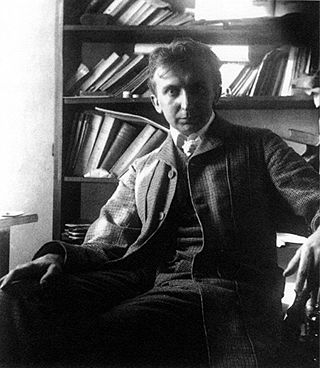
August Endell was a designer, writer, teacher, and German architect. He was one of the founders of the Jugendstil movement, the German counterpart of Art Nouveau. His first marriage was with Elsa von Freytag-Loringhoven.

Elsa Baroness von Freytag-Loringhoven was a German-born avant-garde visual artist and poet, who was active in Greenwich Village, New York, from 1913 to 1923, where her radical self-displays came to embody a living Dada. She was considered one of the most controversial and radical women artists of the era.
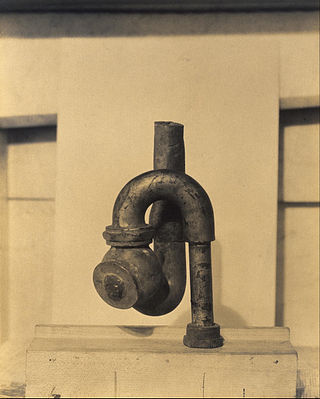
God is a circa 1917 sculpture by New York Dadaists Morton Livingston Schamberg and Elsa von Freytag-Loringhoven. It is an example of readymade art, a term coined by Marcel Duchamp in 1915 to describe his found objects. God is a 10½ inch high cast iron plumbing trap turned upside down and mounted on a wooden mitre box. The work is now in the Arensberg Collection in the Philadelphia Museum of Art.

Experimental literature is a genre of literature that is generally "difficult to define with any sort of precision." It experiments with the conventions of literature, including boundaries of genres and styles; for example, it can be written in the form of prose narratives or poetry, but the text may be set on the page in differing configurations than that of normal prose paragraphs or in the classical stanza form of verse. It may also incorporate art or photography. Furthermore, while experimental literature was traditionally handwritten, the digital age has seen an exponential use of writing experimental works with word processors.

Jane Heap was an American publisher and a significant figure in the development and promotion of literary modernism. Together with Margaret Anderson, her friend and business partner, she edited the celebrated literary magazine The Little Review, which published an extraordinary collection of modern American, English and Irish writers between 1914 and 1929. Heap herself has been called "one of the most neglected contributors to the transmission of modernism between America and Europe during the early twentieth century."
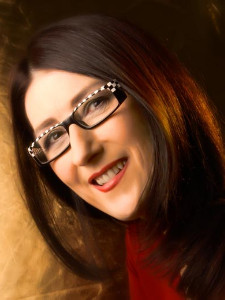
Irene Gammel is a Canadian literary historian, biographer, and curator. Gammel's works critically examine women's contributions to literature and art within the cultural context of the 20th century, shedding light on their experiences, challenges, and achievements. Her research delves into the lives of influential women artists and writers, who were often historically sidelined and erased, analyzing their creative processes, historical struggles, and impact on society.
Tango With Cows: Ferro-Concrete Poems is an artists' book by the Russian Futurist poet Vasily Kamensky, with additional illustrations by the brothers David and Vladimir Burliuk. Printed in Moscow in 1914 in an edition of 300, the work has become famous primarily for being made entirely of commercially produced wallpaper, with a series of concrete poems - visual poems that employ unusual typographic layouts for expressive effect - printed onto the recto of each page.
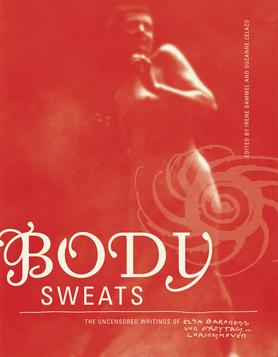
Body Sweats: The Uncensored Writings of Elsa von Freytag-Loringhoven is the first major English collection of poems by dadaist poet and artist Elsa von Freytag-Loringhoven (1874–1927), also known as "The Baroness". Published posthumously in 2011 by MIT Press, Body Sweats was edited by Elsa von Freytag-Loringhoven biographer Irene Gammel and poet and poetics scholar Suzanne Zelazo.
References
- ↑ Kenneth Goldsmith, Duchamp Is My Lawyer: The Polemics, Pragmatics, and Poetics of UbuWeb, Columbia University Press, New York, p. 244
- ↑ Kostelanetz, Richard. "Text Sound Art : A Survey". UbuWeb. Archived from the original on Jun 3, 2023.
- ↑ Germany, SPIEGEL ONLINE, Hamburg. "Alle Galgenlieder von Christian Morgenstern - Text im Projekt Gutenberg". gutenberg.spiegel.de.
{{cite web}}: CS1 maint: multiple names: authors list (link) - ↑ Mizar4590 (2 June 2011). "Zang Tumb Tumb Filippo Tommaso Marinetti". Archived from the original on 2021-12-12 – via YouTube.
{{cite web}}: CS1 maint: numeric names: authors list (link) - ↑ Laurent Cournoyer (24 October 2010). "Kurt Schwitters - Ursonate (1932)". Archived from the original on 2013-12-21 – via YouTube.
- ↑ Gammel, Irene and Suzanne Zelazo, "Harpsichords Metallic Howl—": The Baroness Elsa von Freytag-Loringhoven's Sound Poetry." Modernism/modernity (Johns Hopkins UP), 18.2 (April 2011), 259.
- ↑ Gammel, Irene. Baroness Elsa: Gender, Dada and Everyday Modernity. Cambridge, MA: MIT Press, 2002. 243.
- ↑ Freytag-Loringhoven, Elsa von. Body Sweats: The Uncensored Writings of Elsa von Freytag-Loringhoven. Ed. Irene Gammel and Suzanne Zelazo. Cambridge, MA: MIT Press, 2011. 184-85.
- ↑ "A Sound Poetry Mix Tape", edited by sync.ed & spoken matter, online at Mixcloud, ""
- ↑ it:Giovanni Fontana (poeta)
- ↑ en:Giovanni Fontana (poet)
- ↑ Quoted in Gammel and Zelazo, "Harpsichords Metallic Howl." 259, 261.
- ↑ Quoted in Gammel and Zelazo, "Harpsichords Metallic Howl." 259.